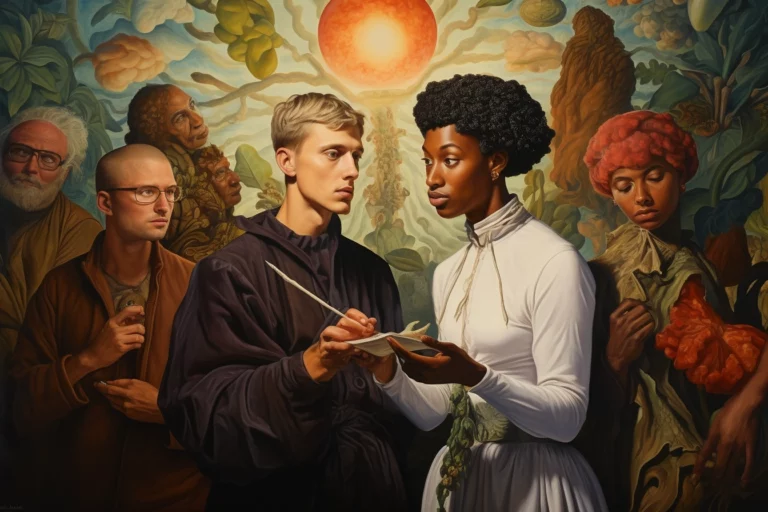When someone mentions psychedelic culture, you may or may not think of queer culture.
The past 20 years has been a rollercoaster of cultural and scientific change. Not just within the psychedelic movement, but for people across the globe. There is one group in particular who’s journey towards normalcy and acceptance has kept close pace with the “psychedelic renaissance”: Queer and LGBTQ+ culture has come a long way since the oppressive, and often violently anti-queer, days of the American 50s and 60s.
Unfortunately, while some things have improved, there’s still significant anti-LGBTQ+ sentiment in the nation. In our last article with Dr. Belser, he highlighted how even within the psychedelic movement there are still challenges. One example he provided was the need to have metal detectors at a recent book signing for his book Queering Psychedelics: From Oppression to Liberation in Psychedelic Medicine, due to threats.
Dr. Alex Belser, MPhil, Ph.D. and a senior psychedelic researcher at Yale School of Medicine. He’s also one of the few openly queer professionals in the psychedelic field. We recently had the chance to sit down with Dr. Belser to discuss all things psychedelic, with a particular focus on the intersection of queer culture and the psychedelic movement.
Coming Out Psychedelic: The Challenge of Being Openly Psychedelic In Psychiatry

During our interview, we spoke to Dr. Belser about what spurred his decision to enter the often weird, often misunderstood world of psychedelic research. Like all good stories, Dr. Belser’s tale starts with a little romance.
“When I was a freshman, a very cute boy down the hall gave me a dog-eared copy of LSD Psychotherapy,” he shares. “[It’s] a book by Stan Grof. His friend had taken it from Tower Records in the nineties. I read this book and was amazed. If you read it, it’s a classic work from the 1970s. Stan Grof knew a lot about LSD and working with it.”
At the time, Dr. Belser says he was searching for meaning in his life and had “started talking with other people who’d had both bad and life-changing/good experiences with psychedelics. And even bad experiences that turned out to be life-changing good experiences.” The result of hearing these stories was that his interest deepened. “Then, when I began training and when we founded the NYU team in 2006, and I started working with patients and interviewing them, my passion grew even more,” he says.
As he continued down this path he found that psychedelic medicine and talk therapy, two areas he’s deeply passionate about, seemed to click. “I love talk therapy and believe it can be profoundly helpful for many people,” Dr Belser says. “But when you thoughtfully combine it with psychedelic therapy, it can truly change the course of a person’s life in ways I hadn’t imagined possible. I wasn’t initially hopeful about certain things, but psychedelics showed me their potential as a catalyst for change when used appropriately.”
However, his decision to explore the psychedelic field was not something that was, at the time, widely accepted. Dr. Belser recounts that he “never openly discussed my psychedelic research, even though I was publishing it. I referred to it as ‘medication-assisted psychotherapy’ instead of ‘psychedelic-assisted psychotherapy.’”
Of course, times have changed, and like so many other things, being openly psychedelic is now more widely accepted. And much like queerness, psychedelics are seen more and more as normal. For example, we can look at the recent Psychedelic Science 2023 Conference in Denver, Colorado. The conference drew in a crowd of well over 10,000 attendees, hundreds of speakers, journalists, media reps, and business owners. Often, the conference looked more like a high-production music venue than anything else.
This serves to highlight the rapid change in public perception that has occurred this decade. According to Dr. Belser, “More and more people, even those outside the typical ‘psychonaut’ community, are showing interest in psychedelics. I find this change heartening and am cautiously optimistic about the future.”
Torch Bearers, How Queer Voices Have Shaped Psychedelia

One of Psycedelia’s most interesting untold tales is that of the impact queer voices have had in space. Queer individuals from those of the counterculture heyday, like Baba Ram Dass and Allen Ginsburg, to modern voices like Dr. Belser, have often had an outsized but unrecognized impact on cultural issues. In the world of psychedelics, Ram Dass went from activity administering LSD to cure bisexuality to writing Be Here Now, his seminal book where the persona of Richard Alpert gave way to the spiritualist, and psychedelic guru Ram Dass. Part of that change was his acknowledgment of his own internalized homophobia. It can be argued that this awakening was part of Ram Dass’ path to becoming one of the most influential queer persons in psychedelic culture.
But what about the untold stories? According to Dr. Belser, queer people have always been “the torchbearers of psychedelic medicine.” Dr. Belser offers that queer involvement in psychedelics can be traced to cultural groups across six continents, where there is some distinct cross-over between marginalized groups. Dr. Belser states, “Often at the margins of the community, there seems to be a crossover between people who carry [psychedelic] medicine traditions and queerness as we currently define it. People who are two-spirit, who do not fit conventional gender norms, who are LGBTQIA, as we might currently think of them. Each of these human civilizations has its own words to describe this, but being gay is not a 20th-century phenomenon — we’ve been around for a long time.”(1, 2)
Dr. Belser takes that further, saying, “I think that queer people are overrepresented in the psychedelic movement… So there’s some crossover there that I’m curious about. I would love for someone to teach me more. But it’s taken some time for our voices to be heard.”
Those voices are growing louder. Today queer people interested in becoming involved in the psychedelic renaissance can look not just at Dr. Belser as someone who’s as proudly queer as they are psychedelic, but to other voices, like Dr. Bia Labat, a queer Brazilian anthropologist living in San Francisco. Queerness and psychedelic culture are also becoming recognized on the institutional level. For example, the Chacruna Institute for Plant Medicines has dedicated entire chronicles to queer culture within the psychedelic movement.
This newfound influence has extended from culture to research. Dr. Belser describes several examples of the exciting work people are doing in the psychedelic field, saying, “People are doing all sorts of fantastic things like ketamine-assisted LGBTQ affirmative psychotherapy. Or looking at things like, ‘How do we get gay men off of crystal meth?’ I don’t think it’s a great drug. People can choose to use what they want, but from a harm reduction perspective, what if we got people off of crystal meth? My colleague, John Hopper, a nurse practitioner in the Bay Area, says, ‘I’ll use everything in the kitchen sink to get people off of meth. I’ll prescribe what I need to, including harm reduction. Let’s get them onto psychedelics, like aphrodisia psychedelics like 2CB.’”
This sort of sentiment may sound wild, but it’s the kind of forward-thinking and pragmatic approach that can save lives. After all, members of the queer community, in particular, are at risk of substance-use disorders with one study showing that slightly over 41% of LGBTQ+ identifying individuals over 18 use some substances like marijuana and other psychoactive drugs. Something that has only increased in recent years. Relatedly, according to one study released last year, methamphetamine use rose in the United States by 47% between 2012 and 2015, while the National Institute on Drug Abuse shows that meth-related deaths rose to over 30,000 in 2021. The aforementioned study also shows that individuals who use methamphetamines during sex (known as chemsex) are 3.70 times more likely to engage in risky behavior.(3, 4, 5, 6)
Chemsex is the practice of taking a compound, such as THC, MDMA, or more dangerous drugs like methamphetamine, and using them during sex. Dr. Belser says this is not as unheard of as you may think: “This idea of having substances while having sex is not uncommon. People drink and have sex all the time. People smoke cannabis and have sex all the time, and people take psychedelics or crystal meth. But, from a research and purely harm reduction focused point of view, there are other, safer things that people can do.”

He suggests that there’s also a real place for queer spirituality within the psychedelic movement. Especially when it comes to harm reduction and getting people to move away from dangerous drugs like methamphetamine. Dr. Belser says that, “There’s the idea of spirituality in a broad sense, queer spirituality in a broad sense. There are incredible people in the community, in underground places, where they’re on land with hundreds of people at a Beltane ceremony: wrapping and weaving the intentions for the new year around the maypole where they’ve cut down a tree. It’s queer people weaving intentions, and hundreds of people at a time taking psilocybin mushrooms together. This is very different from having two therapists in a room with a bed and eye shades. It’s a different treatment model because it’s not a treatment. It’s a whole different expression of the way that we could use psychedelics. And I think we have something to learn from that because these are living lineages of psychedelic practice that many queer people have been carrying underground and passing on from one to another.”
According to Dr. Belser, this new surge of interest in both queer psychedelic culture and LGBTQ+-minded research is a sign that positive change is happening. He says, “To all those young queer individuals interested in psychology, medicine, or psychedelics but hesitant about entering the field, I’ll say: if you feel called to this work, there’s plenty of room for you. The field offers numerous avenues, from science to art to therapy, where you can contribute. If you decide to dive in, I hope you find as much meaning and purpose in it as I have.”
We hope that Dr. Belser’s words speak to you, regardless of your background, sexuality, or anything else, and that you, too, choose to follow that spirit of curiosity and exploration. If the psychedelic movement is to succeed, we need voices of diversity, courage, and sincerity. Voices like yours.
- Carroll, A. (2021). “Twins Twisted into One”: Recovering a Sovereign Erotic in Sun Chief: The Autobiography of a Hopi Indian. American Quarterly, 73(1), 101–122. https://doi.org/10.1353/aq.2021.0005
- Empowering Queer, LGBTQ, and Two-Spirit Voices in Psychedelics with Marca Cassity. (2020, November 6). Chacruna. https://chacruna.net/marca_cassity_two-spirit_lgbtq_psychedelics/
- Halkitis, P. N., Fischgrund, B. N., & Parsons, J. T. (2005). Explanations for Methamphetamine Use Among Gay and Bisexual Men in New York City. Substance Use & Misuse, 40(9-10), 1331–1345. https://doi.org/10.1081/ja-200066900
- National Institute on Drug Abuse. (2017, September 5). Substance Use and SUDs in LGBTQ* Populations. National Institute on Drug Abuse. https://nida.nih.gov/research-topics/substance-use-suds-in-lgbtq-populations
- Moradi, S., Moradi, Y., Rahmani, K., Nouri, B., & Moradi, G. (2022). The association between methamphetamine use and number of sexual partners in men who have sex with men: a systematic review and meta-analysis. Substance Abuse Treatment Prevention and Policy, 17(1). https://doi.org/10.1186/s13011-022-00453-7
- Drug overdose death rates | National Institute on Drug Abuse. (2023, July 10). National Institute on Drug Abuse. https://nida.nih.gov/research-topics/trends-statistics/overdose-death-rates
 David Connell
David Connell Ross Dillon
Ross Dillon 


